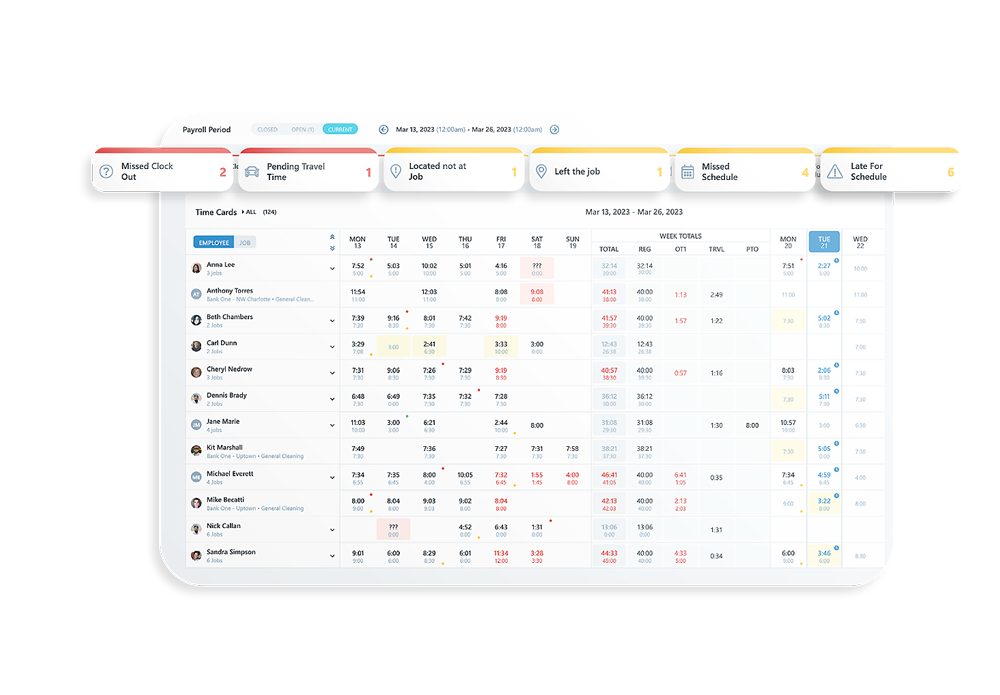Craft a Time Theft Policy with This Simple Step-by-Step Guide

Do you need to create a time theft policy for your employee handbook? Considering that employee theft costs U.S. employers more than $400 billion annually in lost wages and productivity, the answer is clearly "yes." Time theft refers to employees engaging in fraudulent activities, which can include falsifying timesheet records, buddy punching, clocking in a few minutes early, taking extended breaks, clocking in away from the job, and performing personal tasks while on the clock. When time fraud occurs, employee productivity and company resources are negatively impacted.
Establishing a robust time fraud policy sets expectations for employees and legally protects the company when uncovering employee time theft. In this guide, we will explore the crucial aspects of creating a company policy, including establishing consequences, fostering a culture of accountability, and issuing written warnings. By following these steps, companies can promote fairness, integrity, and productivity in the workplace while deterring time theft.
As a bonus, don't miss this interview with Chronotek owner Brandon Fox, who shares 40 years of insights to help small business owners thrive in the service industry.
Short Summary
-
Establishing a clear time theft policy is crucial for businesses to set expectations and provide legal protection.
-
Consequences for employees stealing time should be clearly communicated to deter employees and maintain fairness.
-
Creating a culture of accountability promotes integrity and responsibility, reducing the likelihood of time card fraud.
Table of Contents
- The Importance of a Clear Company Time Theft Policy
- Establishing Consequences for Employee Time Theft
- Creating a Culture of Accountability
- Sample of a Company Policy on Work Hours and Payment
- 4 Steps to Writing a Warning for Time Theft
- Legal Considerations
- Eliminate Time Theft With the Best Time Tracking and Attendance Software
- Summary
- FAQs About Creating a Company Time Theft Policy
The Importance of a Clear Company Time Theft Policy
Let's start with a definition of time theft. At its most basic, time theft is taking pay for hours not worked. Time theft could be a result of gross misconduct or a simple matter of rounding time by a few minutes here and there.
Whatever your time theft definition is, establishing a clear policy is essential for every business for many reasons, including setting expectations, legal protection, and company morale.
Setting expectations: A clear policy communicates to employees what is considered acceptable behavior regarding time management and attendance. It establishes guidelines and expectations for work hours, timekeeping, and proper use of company resources. Does your company round time with the 7-minute rule or use actual time? The policy can also inform employees on how to report time theft.
Legal protection: A well-defined company policy about employee time card fraud provides legal protection for the company. It allows the organization to take appropriate action when employees steal time, ensuring that employees are held accountable and protecting the company's interests.
Maintaining fairness and morale: A transparent policy promotes fairness and equal treatment among employees. It helps prevent resentment or frustration among those who abide by the rules while discouraging misconduct and promoting a positive work environment.
Overall, a clear company policy on employee time card fraud promotes transparency, accountability, and fairness within the organization, fostering a culture of integrity and maximizing productivity.
In the following subsections, we will discuss the crucial aspects of setting up an employee time theft policy, including establishing consequences for when employees commit time card fraud and fostering a culture of accountability.
Are you ready to try a GPS time clock app that ensures employees are at the job site when clocking in?
Establishing Consequences for Employee Time Theft

The purpose of establishing parameters for time theft punishment is to discourage employees from engaging in such behavior. It's essential to have well-defined disciplinary procedures in place to deter other employees from stealing time at work or manipulating their hours.
Consequences for employees stealing time should be clearly communicated to all employees, highlighting the potential ramifications of their actions and ensuring that everyone is aware of the company's stance on this issue. By outlining the consequences and enforcing them consistently, employers can send a strong message that time card fraud will not be tolerated and help prevent future occurrences.
Creating a Culture of Accountability

A culture of accountability refers to a company culture in which employees are held responsible for fulfilling their duties and collaborating to achieve goals and address issues. Establishing a culture of accountability can play a significant role in deterring time card fraud, as employees who feel accountable for their actions are less likely to engage in fraudulent behavior.
To cultivate a culture of accountability within your organization, it is essential to establish clear expectations, reward and acknowledge those who meet them, and foster transparency. These steps also help with employee retention.
Sample of a Company Policy on Work Hours and Payment

-
Work Hours: Employees' work hours begin when they arrive at the client's location and start performing their assigned tasks. Work hours end when the assigned tasks for the day have been completed, and the employee has left the client's location. Any time spent traveling to or from the work location is not included in the work hours unless explicitly stated by the company for specific scenarios.
-
Timekeeping: All employees are required to accurately record their time worked with the company-provided time clock software. Falsification of time worked is a serious offense and may result in disciplinary action, up to and including termination.
-
Clock-In/Out Procedures: Employees must clock in upon arrival at the client's location and begin their work, and employees clock out once they have finished their tasks and are leaving the site. The exact time of clock-in and clock-out will be accurately recorded by the time tracking software.
-
Off-site Work: For off-site work, the company may use a time-tracking system that verifies the employee's location. All employees are required to use this time clock software.
-
Violations: Violations of this policy, including clocking in before arrival at a work location or clocking out after leaving the work location, taking excessive break time, and engaging with social media while on the clock, are considered serious and may result in disciplinary action.
-
Review and Questions: All employees are expected to review this policy. Any questions about the policy should be directed to the Human Resources department or your immediate supervisor.
The purpose of this policy is to ensure fairness and honesty in the workplace while maintaining employee morale, and it's important that all employees abide by these guidelines.
4 Steps to Writing a Warning for Time Theft
Issuing a written warning for employee time theft involves a structured process of gathering evidence, drafting the warning, conducting a meeting with the employee, and documenting the process.
In the following subsections, we'll dive into each of these steps, providing guidance on how to effectively issue a written or verbal warning and ensure that employees understand the consequences of stealing company time.
1 - Gathering Evidence

When gathering evidence to address suspected time theft by an employee, it is important to focus on obtaining objective and verifiable information. Here are some types of evidence you can consider gathering:
Time Records
Review the employee's time sheets, clock-in/out records, or any other time clock systems used in the payroll process of your organization. Look for discrepancies, patterns of irregularities, or instances where the employee's recorded hours do not match their actual presence at work.
Surveillance Footage
If your workplace has video surveillance systems, check the footage to verify the employee's activities during their scheduled work hours. Look for instances of prolonged breaks, unauthorized absences, or any other behavior that suggests employees stealing time. Your off-site customers may also have video footage of your hourly employees.
Witness Statements
Speak with colleagues or supervisors who may have observed the employee's work habits or noticed any suspicious behavior. Gather statements from those who can provide relevant information about the employee's attendance or work-related activities.
Digital Activity Logs
If your organization uses digital systems or tools for work, such as computer software, email, or project management platforms, review activity logs to identify any anomalies or signs of misuse of work hours.
GPS or Location Tracking Data
If employees work remotely or travel as part of their job, GPS or location tracking data from automated time tracking solutions, like Chronotek Pro, may help verify their whereabouts during specific periods. This can be especially useful if you suspect employees of misrepresenting their travel time or working off-site during scheduled hours.
Remember to respect the privacy rights of your employees and ensure that the methods used for gathering evidence comply with applicable laws and company policies. It is also important to maintain the confidentiality of any information obtained during the investigation.
The gravity of the time theft will depend on the company's regulations and the collected evidence. Therefore, employers should exercise caution when gathering evidence and ensure that they have a solid foundation for any disciplinary action taken against an employee.
2 - Drafting the Written Warning

Once you gather sufficient evidence, the next step is to draft the warning. A well-crafted version includes pertinent information such as dates, names, and a description of the behavior in question. The warning should be clear and concise, leaving no room for ambiguity or misunderstanding.
In addition to the specific details of the time theft incident, the warning should outline the time theft punishment if the behavior persists. This may include further disciplinary actions, suspension, or even termination, depending on the severity of the employee theft situation and the company's policies.
Sample Letter to Employee About the Time Theft Meeting
Subject: Important Discussion About Timekeeping and Work Hours
Dear [Employee's Name],
I hope this message finds you well. I'm reaching out to you to discuss an important matter related to your recorded work hours.
I've noticed that there have been several instances where you clocked in before you arrived at the client's location. This is contrary to our company's policy, which stipulates that work hours begin and employees clock in when they arrive on-site at the client's location and begin their duties.
This policy is in place to ensure that we maintain fairness to all our employees and uphold our commitments to our clients. Clocking in before arriving at the job site goes against this policy, and as a company, we place great importance on honesty, integrity, and adherence to these policies.
I am writing this email to clarify these expectations and to express the importance of adhering to the correct time clock procedures. It is crucial going forward that you only clock in with our time and attendance system when you have arrived at the client's location and are ready to begin your tasks.
If there are any concerns or issues that are causing difficulties in adhering to this policy, I encourage you to share them with me or your supervisor. We are here to support you and to address any potential problems that our team members may be facing.
Your contributions to our team are highly valued, and we have faith in your understanding and compliance with our company policies.
Please do not hesitate to reach out if you have any questions about this or any other policy or if you have any other concerns that you would like to discuss.
Thank you for your attention to this matter, [Employee's Name].
Best Regards,
[Your Name]
[Your Position]
3 - Conducting a Meeting with the Employee

Holding a meeting with the employee to issue a written warning is a crucial step in addressing stealing time at work. Conduct the meeting in a confidential setting to ensure privacy and respect for the employee. Explain the rationale for the meeting, present the warning in writing, and discuss the grounds of the warning.
It's essential to allow the employee an opportunity to respond to the allegations and provide any additional information or context that may be relevant. By conducting a thorough and respectful meeting, employers can ensure that the employee understands the gravity of the situation and is aware of the consequences of their actions.
Example of How to Handle the Employee Time Theft Meeting
[Your Name]: Hi [Employee's Name], thank you for taking the time to meet with me today.
[Employee's Name]: You're welcome, [Your Name].
[Your Name]: I wanted to discuss something I've noticed recently regarding your work hours. It appears that you have been clocking in before you arrive at the client's locations. Could you help me understand why this is happening?
[Employee's Name]: [Employee's response]
[Your Name]: I see. As you know, our policy on employee hours states that work hours begin when you start working on-site at the client's location and not before. This ensures that we are fair to all our employees and our clients. Clocking in before arriving at the job site is against our company policy. We value honesty and integrity very highly, and it's crucial for maintaining a good working relationship with our clients and our team.
[Employee's Name]: [Employee's response]
[Your Name]: I appreciate your understanding. It's important that going forward, you only clock in when you have arrived on-site and are ready to begin work. If there are any concerns or if you're facing any issues that are making it difficult for you to comply with this policy, please feel free to share them with me or your supervisor. We want to ensure we're addressing any potential issues that our team members might be facing.
[Employee's Name]: [Employee's response]
[Your Name]: Great, I'm glad we could have this conversation. Let's both aim for better adherence to our company policies moving forward. We really value your work and your contributions to the team, and it's crucial that we all adhere to the same standards and expectations.
If you have any questions about this or any other policy, or if you ever have any concerns or issues you'd like to discuss, please don't hesitate to reach out. Our door is always open.
[Employee's Name]: [Employee's response]
[Your Name]: Thank you for your time today, [Employee's Name]. I'm looking forward to seeing continued excellent work from you. Have a great day!
Remember to keep the tone of the conversation professional and understanding. The goal is to correct behavior, not to chastise or embarrass the employee.
4 - Documenting the Process

Accurate documentation of the process is crucial when issuing a written warning for an employee stealing time at work. The document should include the name of the employee, the date of the incident, a description of the incident, the level/type of discipline, and the consequences of further violations. Additionally, the document should include the name and position of the person issuing the discipline, as well as a request for the employee's signature.
Documenting the process not only provides a record of the disciplinary action but also serves as a reference for future incidents of employee theft. By maintaining accurate records of disciplinary actions, employers can ensure a consistent approach to addressing time theft and protect themselves from potential legal challenges.
Legal Considerations
When addressing the many ways employees steal time at work, employers must be mindful of legal considerations, as the Fair Labor Standards Act (FLSA) requires that employers pay for hours worked. Penalizing employees caught for stealing money or time at work without solid proof of time theft could be considered retaliatory and is not permissible.
While taking legal action against employees stealing company time is possible, it is often more cost-effective and straightforward to focus on prevention and addressing the issue internally. Failing to pay an employee for stolen time may result in a financially burdensome wage-and-hour lawsuit for back pay.
Therefore, it is crucial for employers to approach time theft allegations with caution and ensure that they have sufficient evidence before taking disciplinary action and possibly incurring attorney fees.
Eliminate Time Theft With the Best Time Tracking and Attendance Software

"An ounce of prevention is worth a pound of cure." - Benjamin Franklin
Chronotek Pro's time-tracking software provides the most comprehensive solutions for preventing and eliminating employee time theft. With features like GPS tracking, two-factor authentication, biometric voice verification, reporting and analytics, and NFC-enabled TimeTiles™, Chronotek Pro will not only track employee hours but also prevents the many ways employees commit time theft, leading to lost productivity and unnecessary overtime pay.
The GPS time tracking app allows employers to track employees' locations and detect unauthorized clock-ins or instances of leaving the job site while on the clock. Two-factor authentication and biometric voice verification eliminate buddy punching by ensuring that employees can only clock themselves in and out. Reporting and analytics provide valuable insights to identify patterns and anomalies that indicate when employees steal time.
NFC-enabled TimeTiles™ further ensure that an employee clocks in at the designated job site location. By using these features, Chronotek Pro empowers businesses to regain control over their operations, eliminate time theft, and pay employees for actual hours worked. Eliminating time theft has never been easier.
The Chronotek Pro app also allows employees to track their hours, reducing their worries that you're making illegal changes to their time cards.
Summary
Establishing a clear company time theft policy is of utmost importance for businesses, as it not only sets expectations for employees but also provides legal protection. By establishing consequences for stealing time at work, such as well-defined disciplinary actions, employers can deter employees from wanting to commit time theft and ensure a fair and accountable work culture.
Accurate documentation plays a vital role in issuing written warnings when employees steal time at work, as it provides evidence of the offense, ensures consistency and fairness in the disciplinary process, and serves as a legal safeguard. By effectively addressing employees caught stealing time through clear policies and documentation, businesses can maintain integrity, prevent future occurrences, and protect themselves from potential legal challenges.
For most employers with a mobile work environment, employee time theft can be prevented with automated time-tracking solutions, and Chronotek Pro has the most powerful solutions.
FAQs About Creating a Company Time Theft Policy
Why is it important for a company to have a clear time theft policy?
A clear policy sets expectations for employees and provides legal protection for the company.
What are the consequences of time theft for employees?
Consequences may include disciplinary action, up to and including termination.
What are examples of some types of time theft?
There are various types of time theft including buddy punching which happens when an employee clocks in another worker, taking excessive smoke breaks, personal phone calls, fudging timesheets, and clocking in away from the work site.
How can a company foster a culture of accountability to deter time theft?
A culture of accountability holds employees responsible for their actions and can deter and eliminate time theft by promoting integrity and responsibility. Monitoring employee attendance with the right time clock software can boost accountability.
What should be included in a company's policy on work hours and payment?
A policy on work hours and payment should include guidelines on when work hours start and end, timekeeping requirements, clock-in/out procedures, and possible time theft punishment.
How should employers issue a written citation for time theft?
Issuing a warning in writing involves gathering evidence, drafting the warning, conducting a meeting with the employee, and documenting the process.
What evidence should be gathered before issuing a written reprimand for time theft?
Evidence may include time records, witness statements, or any relevant documentation that supports the time theft allegation.
What should be included in a well-crafted written warning for time theft?
Include specific details of the time theft incident, potential repercussions if the behavior persists, and be clear and concise.
How should employers conduct a meeting with an employee to address time theft?
The meeting should be held in a confidential setting, where the employer explains the purpose, presents the warning in writing, and allows the employee to respond to the allegations.
Why is accurate documentation important when issuing a written notice for time theft?
Accurate documentation provides a record of the disciplinary action, ensures consistency in addressing time theft, and protects the company from potential legal challenges.
What legal considerations should employers keep in mind when addressing time theft?
Employers must be mindful of legal requirements, such as the Fair Labor Standards Act (FLSA), and ensure they have solid proof of time theft before taking disciplinary action. Retaliatory actions without sufficient evidence are not permissible.
Can I be fired if I steal time at work?
Time theft punishment can be severe as stealing company time is a serious offense. If an employee is caught stealing time at work, the employer may take disciplinary action, such as putting the employee on probation, suspending them, or even terminating their employment. Employers have broad authority to fire workers who steal time at work and for any reason at any time, as long as the firing doesn't violate an employment contract and doesn't amount to illegal discrimination. It is important to note that time theft is considered a crime, and in some cases where the total wages paid exceed that of felony theft, a felony crime.
Conclusion
In conclusion, developing a comprehensive time theft policy is essential for businesses to protect their resources, ensure fairness in the workplace, and maintain trust with employees. Following a step-by-step guide can streamline the process and ensure that the policy is thorough and effective. By clearly defining what constitutes time theft, outlining disciplinary measures for violations, and providing guidance on proper time tracking procedures, businesses can establish a framework that promotes accountability and compliance among employees. Additionally, regularly reviewing and updating the policy to address emerging challenges and changes in regulations ensures its relevance and effectiveness over time.
Ultimately, a well-crafted time theft policy not only helps prevent losses due to unauthorized time padding or buddy punching but also fosters a culture of honesty and integrity within the organization.
By embracing these solutions, you can simplify payroll processes, reduce administrative burdens, eliminate time theft, and minimize costly mistakes. Invest in an automated time clock system to save time and money while ensuring accurate and efficient payroll calculations. With the right tools and processes, you can focus on more strategic aspects of your business and watch your profits grow.





